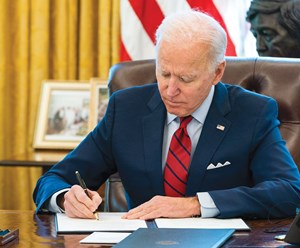Special Focus: 2021 Forecast & Review – Washington Outlook
In November, former Vice President Joseph Biden defeated incumbent President Donald Trump, winning 51.3% of the vote compared to 46.9% for Trump. Biden’s margin was 7.1 million votes, and 306 Electoral College votes, compared to Trump’s 232. However, margins in several key states were close—21,000 votes in Wisconsin and 12,000 in Georgia.
The election was not a down-ballot victory for Democrats: They experienced a net loss of 10 House seats but retained a majority of 221 seats to Republicans’ 211 seats.1 Democrats currently have the smallest House majority of any party in two decades.
However, ominously for the oil and gas (O&G) industry, Democrats gained three Senate seats, giving them a total of 48. Independents, who caucus with the Democrats, won two seats. Since Vice President Kamala Harris breaks a 50-50 Senate tie, Democrats effectively control the Senate and all three government branches.
THE BIDEN ADMINISTRATION
On his first day as President, Biden recommitted the U.S. to the Paris Climate Agreement, rescinded the construction permit for the Keystone XL oil pipeline, and ordered federal agencies to begin reinstating over 100 environmental regulations rolled back by Trump—including ones governing methane leaks from O&G wells and greenhouse gas (GHG) emissions from vehicle tailpipes. Other Biden Executive Orders include a temporary moratorium on oil and gas leasing activities in ANWR, and one requiring government agencies to “address climate change,” Fig. 1.

Biden’s top environmental and energy positions are being filled by climate alarmists that are critical of the O&G industry. Biden nominated Michael Regan, secretary of North Carolina’s Department of Environmental Quality, to head EPA, Rep. Deb Haaland (Dem.-N.M.) for Secretary of the Interior, and former Michigan Gov. Jennifer Granholm (Dem.) as Secretary of Energy. Haaland is a co-sponsor of the Green New Deal (GND), has opposed O&G production on federal lands, and supports a fracing ban.
In addition, Biden nominated Gina McCarthy as White House Senior Adviser on Climate Change. She was chief architect of former President Barack Obama’s GHG rules, which were repealed by the Trump EPA. Former Obama Secretary of State John Kerry was nominated to be Special Presidential Climate Envoy. Kerry helped draft the 2016 Paris Climate Accord and has labeled climate change as “the most serious threat to mankind.”
Meanwhile, U.S. Appeals Court Judge Merrick Garland was nominated to be Attorney General. He has extensive expertise on environmental law and, under him, the Justice Department may become a “powerful climate agency through strict enforcement of laws already on the books.” Former presidential candidate and South Bend, Ind., Mayor Pete Buttigieg was nominated to be Secretary of Transportation, and former Federal Reserve chair (under Obama) Janet Yellen was nominated to be Treasury Secretary. Buttigieg has labeled climate change a “national emergency” and advocates the GND. Yellen served as White House Council of Economic Advisers Chair in the Clinton Administration, and she advocates CO2 emissions taxes, cap-and-trade, and similar policies. She labeled climate change an “existential threat” and pledged to create a Treasury team to focus on climate change.
Biden has nominated former Obama Commodity Futures Trading Commission (CFTC) head Gary Gensler as Securities and Exchange Commission Chair. He is a regulation-prone progressive and may require financial markets to impose stringent environmental/social/governance (ESG) disclosures, increased corporate reporting on GHG emissions, and “evaluation and pricing of climate risk.” This could require companies to list “climate-related threats,” thus reducing their long-term value.
Biden pledges not to ban fracing, but he can still inhibit O&G production by obstructing federal O&G leasing. He can require a comprehensive review of the Bureau of Land Management’s (BLM’s) leasing program, which could take years. While in progress, BLM is not allowed to issue new leases, and industry cannot appeal. President Obama did this with coal mining. It would be easier than an outright ban on new federal leases, which would draw legal challenges. The review would most affect new wells in New Mexico’s portion of the Permian basin, one of the most prolific shale fields with some of the lowest break-even costs.
A carbon tax is not likely, but the Federal Energy Regulatory Commission (FERC) can impose regional carbon prices. Biden has appointed Democrat Richard Glick to be FERC’s chairman, thereby flipping control to Democrats. Glick has served as a FERC commissioner since November 2017. FERC is already evaluating carbon pricing in regional power markets and could finalize its position in 2021.
Obama’s Clean Power Plan (CPP) failed, because regulating carbon emissions under the Clean Air Act was legally dubious. While Biden will likely seek to revive carbon rules—this time emphasizing natural gas (NG) emissions—the effort will experience legal delays. However, he can announce new limits on power plant emissions other than carbon, including PM, SOx, and NOx.
Biden pledges a green electric grid by 2035, but he has not specified how. Renewable energy (RE) targets need approval by Congress, but even with Democrats in control of both chambers, it will be difficult to derive a policy supported by every state. Biden would probably get unanimous opposition from Republicans, and would not get unanimous support from Democrats.
Obama failed to enact GHG trading, when Democrats had large congressional majorities, and prospects for a GND are nil. Biden may try to revive the Clean Power Plan (CPP) in a form that survives court challenges. Advocates are urging a Presidential declaration of climate change as a “national security emergency” under the National Emergencies Act. Biden could then divert defense funds to RE projects. He also could suspend existing O&G leases on federal land, accelerate vehicle emissions standards, cancel pipeline projects, and limit energy exports. Further, Biden-Harris may revive the plan to federally prosecute O&G executives as “climate deniers.”
SENATE IMPLICATIONS
While the Presidential race generated most interest, the Senate was arguably just as important. The Democrats’ Senate gives them control of the legislative agenda, budget, judicial confirmations, and operations of both Houses of Congress. There will likely be impending Supreme Court vacancies, and the Senate confirms Court nominations. Further, a unified Democratic Congress is a major advantage for Biden. Democrat control of both Congress and the White House will ensure a plethora of economic, energy, environmental and regulatory legislation detrimental to the O&G industry.
Liberal senators like Elizabeth Warren (Dem.-Mass.) and Bernie Sanders (Indep.-Vt.) will push Biden to the left, and an evenly divided Senate creates a high-profile role for Vice President Harris. The Democrats’ fortunes could erode in two years, since a President’s party typically loses seats in mid-term elections, giving Biden a small window for action—which Biden recognizes.
The Democrat Senate allows Biden to advance his agenda, and his cabinet and sub-cabinet nominations will be facilitated. This could lead him to choose more anti-O&G candidates. Democrat Senate control implies climate initiatives funding, anti-O&G legislation, policy implementation through the reconciliation process, and climate legislation. It will facilitate reversal of Trump’s energy agenda by utilizing the Congressional Review Act (CRA), which allows the Senate and House to overturn regulations finalized by the President in the previous 60 legislative days, using a majority vote. Trump accelerated federal rule-making during his final months in office, and CRA allows the Senate and House to overturn such “midnight regulations.” Rules at risk include 11 EPA regulations, one rescinding regulation of methane gas emissions by oil companies, and one prohibiting banks from refusing to lend to O&G companies.

Senate Majority Leader Chuck Schumer (Dem.-N.Y.) has pledged to advance green infrastructure and various anti-fossil fuels legislation. However, legislation is unlikely to follow a purely progressive Democrat agenda. There will still be requirements for bipartisan legislation, and power is likely to accrue to moderates. The winners may be the centrist Republicans and Democrats, and they may be the power brokers.
Joe Manchin (Dem.-W.Va.)—one of the few energy-rational Democrats—will head the Senate Energy and Natural Resources Committee, Fig. 2, and John Barasso (Rep.-Wyo.) will serve as Ranking Member. Both come from fossil fuel states, which could limit anti-O&G legislation. Manchin once famously put a bullet through the Waxman-Markey cap-and-trade bill for a campaign ad and has stated, “You cannot eliminate your way to a cleaner environment.” He may have played a role in determining that Glick would be the next FERC chair. FERC’s priorities will depend on what passes Congress. Thus, a clean energy standard will require FERC to ensure that transmission providers are developing compatible infrastructure and market structures.
Manchin has enormous leverage, because losing even one Democrat vote could mean a bill’s defeat. He may hold the Senate’s 50th vote and the power to decide whether legislation succeeds. It is no exaggeration to state that he will control the legislative branch: If Republicans unite in opposition to a Biden nominee, it will most likely be Manchin who decides whether that individual is confirmed, and when Biden negotiates a budget or energy bill, Manchin will play an outsized role.
O&G INDUSTRY REACTS
The U.S. O&G industry is preparing legal challenges, and trade groups are monitoring Biden initiatives to regulate the energy sector and limit fracing. The industry learned during the Obama Administration that it was imperative to sue, to defend vital interests. Action on Biden’s campaign pledge to halt all new permits for fracing on public lands will likely trigger lawsuits, as will efforts to conduct programmatic analyses of federal energy development. Attempts to halt lease sales or permitting approvals will also generate industry challenges.
Just as environmental groups and blue states united in court against the Trump Administration, O&G industry interests and red states will challenge the Biden Administration. Some of the same collaborations between trade groups and Republican attorneys general who opposed high-profile Obama-era regulations like the CPP are likely, and state challengers include Texas and West Virginia.

Overall, reactions of O&G trade groups to the election were mixed. The Western Energy Alliance (WEA) has already begun to sue Biden in court over his federal lands leasing ban, Fig. 4. Previously, WEA had led legal challenges opposing Obama-era regulations, including litigation over BLM’s methane emissions regulations of O&G on public lands. The New Mexico Oil and Gas Association raised concerns about Biden’s statements on fracing, but did not threaten litigation.
Other energy trade groups have been more conciliatory. The Interstate Natural Gas Association of America (INGAA) and American Petroleum Institute (API) offered congratulations to Biden. INGAA stated “Natural gas and related infrastructure has enjoyed bipartisan support for decades, and it is our goal at INGAA to keep it that way. We stand ready to work with the President-elect’s nominees.” API stated, “We share President Biden’s goal of leadership in addressing climate change, and we support the ambitions of the Paris Agreement.” Perhaps INGAA and API should recall Churchill’s warning from the 1930s: “An appeaser is one who feeds a crocodile—hoping it will eat him last.”
UNDUE O&G CONCERNS?
There is justifiable concern over the Biden Administration. However, Presidents often have less influence than commonly thought, and the O&G industry will be likely more affected by other factors, such as the success of dealing with Covid-19, international markets, technology, etc. For example, the George W. Bush Administration favored the O&G industry: Bush was a former Texas oilman and his Vice President, Dick Cheney, served as Halliburton CEO. Nevertheless, U.S. oil production declined while they were in office—from 5.8 MMbpd in 2000 to 5.0 MMbpd in 2008, and U.S. natural gas production increased only 6%.
Obama was openly hostile to the O&G industry—slowing pipeline permits, placing more federal lands off-limits to drilling, etc. However, under Obama, the U.S. witnessed the fastest growth of oil production in history and the largest expansion under any President: U.S. oil production increased nearly 90%, and natural gas production increased by more than 34%. Of course, O&G production increased, due to hydraulic fracturing despite Obama’s policies, not because of them. Thus, technology and investment swamped policy and ideology.

Biden campaigned on similar themes as Obama and will likely implement similar policies. He may slow approval of pipelines, inhibit drilling on public lands, and implement other deleterious policies. However, Biden’s impact on the O&G industry will likely be similar to that of his predecessors. He will pass some policies that have small, incremental impacts, but those will be noise against macro factors like new technology and Covid-19. The largest impact that he could make would be to rapidly get Covid-19 under control, which would allow O&G to rebound significantly.
The NG industry may have a brighter future than oil under Biden, even though he has pledged an ambitious emissions-cutting agenda, Fig. 3. Consolidation is already underway in the oil sector, with some smaller players in the field attractive to buyers. While oil may be struggling, NG is simply indispensable to providing the reliability that renewables cannot. Shifting to renewables increases blackout risks, and reliability of power supply ensures the long-term future of natural gas, even with increasingly ambitious climate goals. Renewables produce power intermittently and require energy storage, which is expensive and insufficient. Gas is not intermittent, and the U.S. has abundant supplies. Due to forecasts for a rebound in demand for NG, producers have been increasing their output, while limiting oil production.
Natural gas is trapped between the power industry’s decarbonization strategy and the impetus to replace gas with renewables. Other challenges include fugitive methane emissions and growing electrification of the energy system. The methane issue is germane, and industry has been proactive in reducing emissions. The electrification issue may become an opportunity, as renewables’ inherent disadvantages prevent them from meeting incremental electricity demand. Emission-cutting targets are fine until realization that demand is growing sinks in. We will continue to require fossil fuels, and natural gas is best-placed to meet this demand.
Nevertheless, serious challenges are looming for the O&G industry, and vigilance is warranted.
1Three seats remain vacant.

- The last barrel (February 2024)
- E&P outside the U.S. maintains a disciplined pace (February 2024)
- Prices and governmental policies combine to stymie Canadian upstream growth (February 2024)
- U.S. producing gas wells increase despite low prices (February 2024)
- Executive viewpoint: TRRC opinion: Special interest groups are killing jobs to save their own (February 2024)
- U.S. drilling: More of the same expected (February 2024)
- Applying ultra-deep LWD resistivity technology successfully in a SAGD operation (May 2019)
- Adoption of wireless intelligent completions advances (May 2019)
- Majors double down as takeaway crunch eases (April 2019)
- What’s new in well logging and formation evaluation (April 2019)
- Qualification of a 20,000-psi subsea BOP: A collaborative approach (February 2019)
- ConocoPhillips’ Greg Leveille sees rapid trajectory of technical advancement continuing (February 2019)


